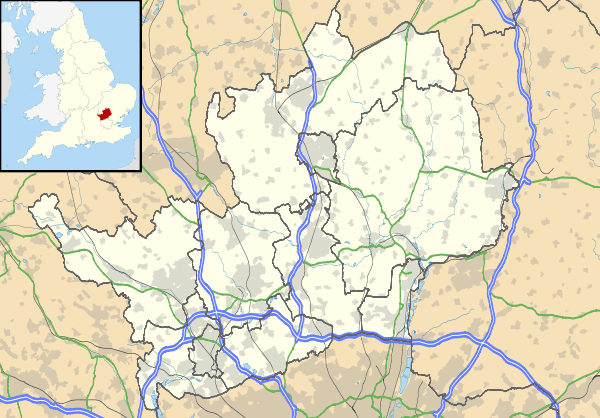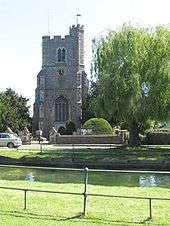Broxbourne
| Broxbourne | |
 Broxbourne |
|
| Population | 13,298 (2001) 15,303 (2011. 2 Broxbourne Wards)[1] |
|---|---|
| OS grid reference | TL365075 |
| District | Broxbourne |
| Shire county | Hertfordshire |
| Region | East |
| Country | England |
| Sovereign state | United Kingdom |
| Post town | BROXBOURNE |
| Postcode district | EN10 |
| Dialling code | 01992 |
| Police | Hertfordshire |
| Fire | Hertfordshire |
| Ambulance | East of England |
| EU Parliament | East of England |
| UK Parliament | Broxbourne |
|
|
Coordinates: 51°44′58″N 0°01′18″W / 51.7495°N 0.0216°W
Broxbourne is a commuter town in the Broxbourne borough of Hertfordshire in the East of England with a population of 13,298 in 2001,[2] increasing to 15,303 at the 2011 Census for the sum of the two Broxbourne Wards.[1]
It is located 17.1 miles (27.5 km) north north-east of Charing Cross in London and about a mile (1.6 km) north of Wormley and south of Hoddesdon. The town is near to the River Lea which forms the boundary with Essex and is 4.5 miles (7.2 km) north of the M25 motorway. To the west of the town are Broxbourne Woods, a National Nature Reserve.[3]
The Prime Meridian passes to the east of Broxbourne.
History
The name Broxbourne is believed to derive from the Old English words brocc and burna meaning Badger stream.[4]
Broxbourne grew up on the Great Cambridge Road, now known as the A10. A number of old houses and inns dating from the 16th to the 19th century still line the High Street (now the A1170).[5] The Manor of Broxbourne is described in the Domesday Book, which mentions Broxbourne Mill. The manor was held in the time of Edward the Confessor by Stigand, the Archbishop of Canterbury, but had passed into Norman hands following the Conquest. King John granted the manor to the Knights Hospitallers until the Dissolution, when it passed to John Cock, after whose family Cock Lane is named.[6]
The parish church of St Augustine was entirely rebuilt in the 15th century, although a 12th-century Purbeck marble font survives. The interior has a number of monuments and brasses dating from the 15th to the 19th century. The three stage tower has a belfry with a peal of eight bells, three of which are dated 1615.[7]
The New River which passes through the centre of the town, was constructed in the early 17th century. Broxbourne railway station was built in 1840. A terra cotta works was opened soon afterwards[8] by James Pulham and Son, who specialised in creating artificial rock garden features; some of their work survives in the gardens at Sandringham House and Buckingham Palace.[9]
The area was exploited for its gravel and sand extraction in the twentieth century that finally came to an end when the mineral reserves were exhausted in the late 1960s leaving a myriad of water filled lakes. Several of the lakes became form part of the Lee Valley Regional Park.[10]
Local government

Broxbourne was a civil parish in the Ware Rural District from 1894 to 1935. In the latter year the more heavily populated eastern end of the parish was added to the Hoddesdon Urban District, while the rural western portion remained in Ware Rural District, forming part of the civil parish of Brickendon Liberty.
The former area of Hoddesdon Urban District merged with that of Cheshunt Urban District to form the Borough of Broxbourne in 1974, under the Local Government Act 1972.
Broxbourne now forms one of thirteen wards of the borough, returning three councillors.[11]
Sport and leisure
Broxbourne has two Non-League football clubs Broxbourne Borough V. & E. F.C. and London Lions F.C., who both play at Goffs lane.
2012 Summer Olympics
As part of the London 2012 Summer Olympics, Spitalbrook was chosen as the venue for whitewater canoe and kayak slalom events. On 8 October 2007 the Olympic Delivery Authority (ODA) announced that due to contamination risks at the planned Spitalbrook site, an alternative site six miles (10 km) south was being investigated.[12] Subsequently on 16 April 2008 it was announced that the venue would be built at nearby Waltham Cross and situated on what was (at the time of the relevant press release) the overflow car park for the showground at the River Lee Country Park.[13] The venue was initially known as Broxbourne White Water Canoe Centre and later officially named Lee Valley White Water Centre.[14]
Notable residents
- Sir Edward Thackeray, recipient of the Victoria Cross
- Broxbourne's Hedgegrove Farm was home to Dina St Johnston, who founded the UK's first independent software house.
- Charles Deville Wells, known as ″the man who broke the bank at Monte Carlo" (born in Broxbourne High Road in 1841).[15] He was baptised by the Rev. Francis Thackeray, who was an uncle of the writer William Makepeace Thackeray and father of Sir Edward Thackeray (see above).
See also
References
- 1 2 Broxbourne Town population 2011
- ↑ "Office for National Statistics, 2001 Census, Key Statistics for HCC settlements. Usual resident population (numbers)" (PDF).
- ↑ http://www.naturalengland.org.uk/ourwork/conservation/designatedareas/nnr/1005000.aspx
- ↑ History of Broxbourne Archived January 9, 2015, at the Wayback Machine.
- ↑ http://www.british-history.ac.uk/report.aspx?compid=43639
- ↑ http://www.british-history.ac.uk/report.aspx?compid=43639#s3
- ↑ http://www.british-history.ac.uk/report.aspx?compid=43639#s16
- ↑ http://www.albury-field.demon.co.uk/bxind.htm
- ↑ http://www.parksandgardens.ac.uk/index2.php?option=com_content&task=view&id=336&pop=1&page=5&Itemid=1
- ↑ History of Broxbourne Retrieved 8 January 2015 Archived January 9, 2015, at the Wayback Machine.
- ↑ Councillors (Borough of Broxbourne Online), accessed September 24, 2007 Archived October 25, 2007, at the Wayback Machine.
- ↑ Olympic Delivery Authority update
- ↑ New Canoeing venue in Broxbourne confirmed for the London 2012 Olympic Games London2012.com Press Release, 16 April 2008
- ↑ London2012.com venue page
- ↑ Quinn, R.: The Man Who Broke the Bank at Monte Carlo (Stroud: The History Press: 2016). ISBN 0750961775.
| Wikimedia Commons has media related to Broxbourne. |